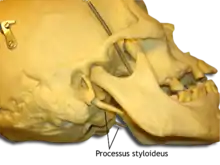Processus styloideus
Processus styloideus (dt. Griffelfortsatz, von lat. Processus „Fortsatz“; Pl. Processus styloidei [pʀotsesˈus]) ist die anat. Bezeichnung für einen stabförmigen Knochenfortsatz.

Processus styloideus ossis temporalis
an einem Humanpräparat
an einem Humanpräparat
Bei Säugetieren kommen vor:
- Processus styloideus ossis temporalis an der Pars petrosa des Schläfenbeins (Fossa retromandibularis): Er geht über in das Ligamentum stylohyoideum. Dieses Band aus Bindegewebe wiederum endet am Zungenbein (Os hyoideum) und dient dessen Aufhängung. Ein überlanger Processus styloideus führt zum sogenannten Eagle-Syndrom (Stylohyoid-Syndrom).
- Processus styloideus radii: stumpf, am seitlich-unteren Ende der Speiche (Radius)
- Processus styloideus ulnae: stumpf, am unteren Ende der Elle (Ulna): Er steht an der Kleinfingerseite oberhalb des Handgelenks mehr oder weniger deutlich hervor und ist Ansatz für das Ligamentum collaterale carpi ulnae.
.png.webp)
Processus styloideus ossis temporalis (Nahaufnahme)
Oberhalb ist der Gehörgang zu erkennen
Oberhalb ist der Gehörgang zu erkennen
This article is issued from Wikipedia. The text is licensed under Creative Commons - Attribution - Sharealike. The authors of the article are listed here. Additional terms may apply for the media files, click on images to show image meta data.